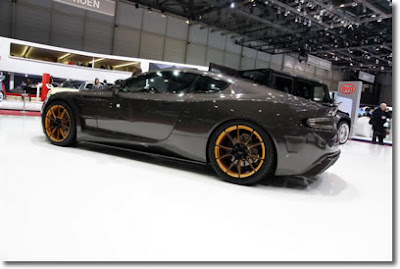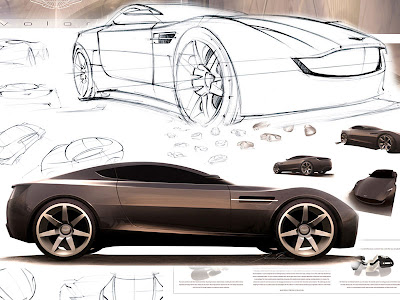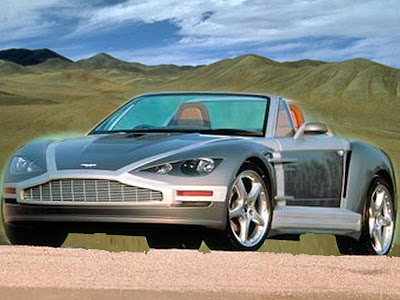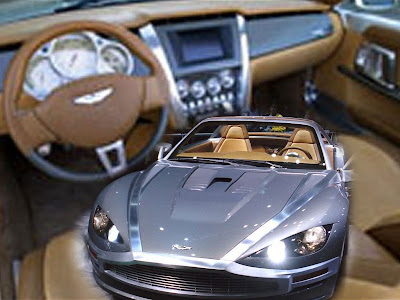Aston Martin Chief Executive Officer, Dr Ulrich Bez, said: "The Aston Martin DBS is the ultimate expression of Aston Martin's engineering and technical ability. It offers pure performance without compromise. The Aston Martin DBS delivers the complete driving experience and bridges the gap between our road and track cars - the Aston Martin DB9 and Aston Martin DBR9."
A combination of elegant design, innovative manufacturing processes, race-derived materials and components and Aston Martin's unrivalled hand-build expertise makes the Aston Martin DBS a luxury sports car without equal. Every line, crease and curve conveys the enormous potential of the Aston Martin DBS, a seductive blend of refinement and raw power, provided by the hand-built V12 producing 380kW (510bhp/517PS), a top speed of 191mph (302km/h) and a 0-62mph (0-100km/h) time of 4.3 seconds.
Aston Martin DBS: Performance
At the heart of the Aston Martin DBS is a 6.0-litre V12 engine. The DBR9 and DBRS9 race cars are powered by an enhanced version of this same V12, tuned to produce in excess of 600bhp. The shared powerplant continues the strong link between Aston Martin's road and race cars, just as the six-cylinder engine used in the DBR1 also powered the Aston Martin DB4, DB5 and DB6 in the 1950s and 60s.
The new panel-making procedure delivers an industry-best surface finish, thanks to a patented 'Surface Veil' process. The application of a 200 micron layer of epoxy and glass to the panel delivers a class-A surface that is in line with Aston Martin's tradition of high-quality finishes. Inside the car, the weave patterns on the exposed carbon-fibre elements have been carefully selected to present the most harmonious surfaces.
Aston Martin DBS: ControlAs with the DB9 and DBR race cars, the Aston Martin DBS benefits from the inherent characteristics of the VH architecture. The VH underframe consists of pressed, extruded and cast aluminium components, bonded together to create an immensely strong underlying structure.
This structure means that weight is kept to a minimum, with the front-mid mounted engine and rear-mid mounted transaxle ensuring a near perfect weight distribution: 85% of the car's weight is positioned within its wheelbase. The Aston Martin DBS's polar moment of inertia is therefore very low, producing a car with natural agility, a strong, stable platform for the V12's high power output and an exhilarating driving experience.
The damper settings are determined by an electronic control unit which takes sensor readings from the car's systems, including throttle position, brake position, steering wheel rotation and vehicle speed. This data establishes the prevailing driving conditions and the demands the driver is making on the car.
The Aston Martin DBS's Adaptive Damping System perfectly captures the car's sporting character, ensuring that stiffer dampers are available for better handling and control when the car is being driven enthusiastically, without compromising ride comfort during 'normal' driving conditions. A designated 'Track' mode automatically sets all dampers to their firmest positions, making it ideal for circuit driving. The Aston Martin DBS is fitted with Pirelli P-Zero tyres that have been developed especially for the car, along with new 20" lightweight alloy wheels.
Aston Martin DBS: DesignThe Aston Martin DBS is manufactured using the finest materials, with a combination of hand-finishing and pioneering high-technology processes. From the exceptional quality of the design and finish to the advanced production techniques employed to save weight and create strength, the DBS is both a technological masterpiece and a powerful visual and tactile experience, inside and out.
The Aston Martin DBS is the culmination of the DB bloodline, a synthesis of race-bred technology and road-going practicality that can be traced back to the iconic Aston Martin DB2, DB3S and DB4 GT, and is continued today with the DBR9 and DBRS9 race cars. The DBS's powerful, flowing form fuses the visual language of the DBR9 GT1 race car with the innate elegance of the DB series. Lower and tauter than other Aston Martin production models, the DBS has subtly flared wheel arches accommodating standard 20" diameter wheels and tyres.

The interior of the Aston Martin DBS represents the epitome of Aston Martin's commitment to using materials honestly, without disguise or embellishment. Lightweight materials are used throughout to save weight; door pulls are made from carbon-fibre, for example, and the carpet has been woven with lighter fibres to save valuable kilograms. Special semi-aniline leather is used throughout the cabin, saving weight as well as giving a soft feel and distinctive aroma.
The combination of Kevlar and carbon-fibre provides crucial weight saving by allowing the structure of the seat to be incredibly slim: between 2.5mm and 3mm. Overall, the trimmed seat provides a weight saving of 20kg. The lightweight seats are a fixed structure, but can be adjusted for rake as well as sliding fore and aft.
The Aston Martin DBS start sequence blends tradition with high technology and a touch of theatre. The ignition ECU (Emotion Control Unit) has evolved into a machined and highly tactile polished sapphire ECU, incorporating a stainless steel inner case. Resembling a fine wristwatch or a piece of contemporary sculptural jewellery, this sapphire ECU epitomises the spirit of the Aston Martin DBS.
To operate the car, the sapphire ECU is inserted into a special docking station in Aston Martin's signature dashboard-mounted sapphire starter button, and glows red to indicate when the car is ready to start. The engine is fired by pressing the ECU flush with the surface of the starter button. After pressing to stop the engine, the ECU automatically motors out of the dashboard for removal.
The start sequence of the Aston Martin DBS is augmented by an all-new centre console design with a cast metal surround, crisp typography and new graphics. The new console has a traditional dial-face clock at the centre, flanked by two rotary controls for the heating and air-conditioning system, fashioned from solid, turned aluminium.
Aston Martin DBS Specification
 Body
Body* Two-door coupe body style with 2+0 seating
* Bonded aluminium VH structure
* Aluminium, magnesium alloy and carbon-fibre composite body
* Extruded aluminium door side-impact beams
* High Intensity Discharge (HID) headlamps (main beam)
* LED rear lamps and side repeaters
Engine* All-alloy, quad overhead camshaft, 48-valve, 5935cc V12.
* Compression ratio 10.9:1
* Front-mid mounted engine, rear-wheel drive
* Fully catalysed stainless steel exhaust system with active bypass valves
* Max power: 380kW (510bhp/517 PS) at 6500rpm
* Max torque: 570Nm (420 lb.ft) at 5750rpm
* Acceleration: 0-100 km/h (0-62mph) in 4.3 seconds
* Max speed: 302 km/h (191mph)
Transmission* Rear-mid mounted, six-speed manual gearbox
* Alloy torque tube with carbon fibre propeller shaft
* Limited-slip differential
* Final-drive ratio 3.71:1
Wheels and Tyres* Front: 8.5'' x 20'' Pirelli P Zero 245/35
* Rear: 11'' x 20'' Pirelli P Zero 295/30
Steering* Rack and pinion, Servotronic speed-sensitive power-assisted steering, 3.0 turns lock-to-lock. Column tilt and reach adjustment
Suspension* Front: Independent double wishbone incorporating anti-dive geometry, coil springs, anti-roll bare and monotube adaptive dampers
* Rear: Independent double wishbones with anti-squat and anti-lift geometry, coil springs, anti-roll bar and monotube adaptive dampers
* Adaptive Damping System (ADS) with Track mode
Brakes* Front: Ventilated carbon ceramic discs, 398mm diameter with six-piston calipers
* Rear: Ventilated carbon ceramic discs, 360mm diameter with four-piston calipers
* Dynamic Stability Control (DSC) with Track mode
* Anti-lock Braking System (ABS)
* Electronic Brakeforce Distribution (EBD)
* Emergency Brake Assist (EBA)
* Traction control
Dimensions* Length: 4721mm (185.9'')
* Wheelbase: 2740mm (107.9'')
* Width: 1905mm (75'') (exc. Mirrors) 2060mm (81.1'') (inc. Mirrors)
* Fuel tank capacity: 78 litres (17.2 Imp.galls, 20.5 US galls)
* Height: 1280mm (50.4'') Weight: 1695kg (3737lb)





















































